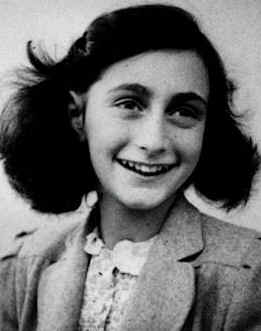
The exact date is undetermined, but on or about this day 70 years ago, in 1945, Anne Frank perished at the Bergen-Belsen concentration camp.
Annelies Marie “Anne” Frank, born on June 12, 1929, and only 15 years old at her death, has become quite possibly the single most recognizable face of the Holocaust in the world. Her wartime diary, later titled The Diary of a Young Girl, has served as the basis for several plays and films. Born in Frankfurt, Germany, she lived most of her life in or near Amsterdam, in the Netherlands.
The Jewish Frank family moved from Germany to Amsterdam in 1933, the year the Nazis took power in Germany. By May 1940, they were trapped in Amsterdam by the German occupation of the Netherlands. As persecutions of the Jewish population increased in July 1942, the family went into hiding in some concealed rooms in the attic of the building where Anne’s father worked. A handful of non-Jewish fellow employees helped the Frank family survive, for which they risked their lives.
During that time Anne documented her experiences in a diary, which was given to Anne on her 13th birthday, chronicling her life from June 12, 1942 until August 1, 1944. She wrote in Dutch, revealing a surprisingly mature outlook on life, and expressing an almost boundless optimism and faith in humanity.
On Wednesday, April 5, 1944, she confided some of her aspirations for the future:
“I finally realized that I must do my schoolwork to keep from being ignorant, to get on in life, to become a journalist, because that’s what I want! I know I can write, but it remains to be seen whether I really have talent….
“And if I don’t have the talent to write books or newspaper articles, I can always write for myself. But I want to achieve more than that. I can’t imagine living like Mother, Mrs. Van Daan, and all the women who go about their work and are then forgotten. I need to have something besides a husband and children to devote myself to!”
After two years, the group was betrayed and transported to concentration camps. Anne Frank and her sister Margot were eventually transferred to Bergen-Belsen, where they died, probably of typhus, in March 1945. British troops liberated the camp on April 15, 1945.
Otto Frank, who lived until 1980 but in 1945 was the only survivor of his family, returned to Amsterdam after the war to find that Anne’s diary had been saved. His efforts led to its publication in 1947. It has since been translated into many languages. It was first published in English in 1952 as The Diary of a Young Girl. Her international posthumous fame helped to guarantee that the memory of the Holocaust would never be lost, and drew special attention to the estimated 1.5 million Jewish children killed.
Photo: Wikipedia (CC)










